Storli Gard: Norway's oldest beer?
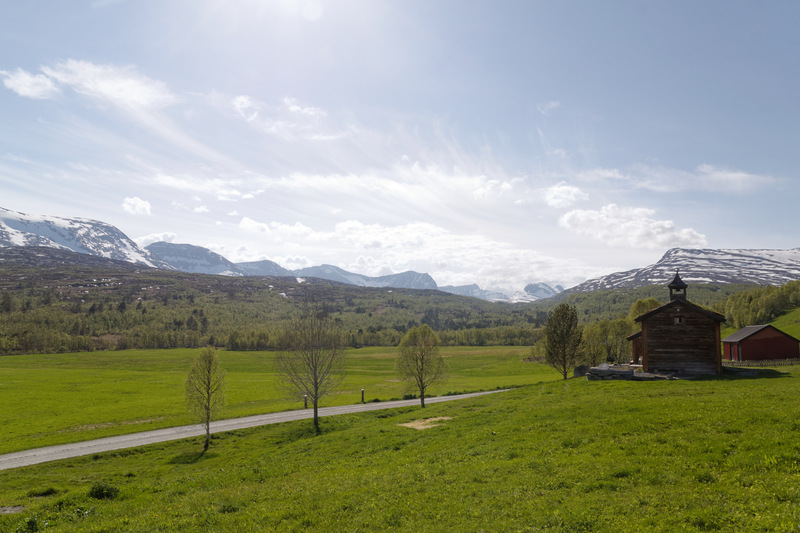
The view from the farm |
Leaving Sunnmøre we drove for many hours along narrow mountain valleys. It was a completely different landscape: spruce forest, bare rocks, some farmland, no fjords. Eventually, we left the highway, then turned back west again, following progressively smaller and smaller roads into the mountains. The whole way the view was almost impossibly gorgeous, as if someone had arranged every mountain, house, and cluster of trees for maximum effect. Eventually, the road ended in front of a cluster of wooden houses. There were no signs, but from the map we assumed this had to be our destination: Storli Gard. (This is part 7 of the Norwegian farmhouse ale trip.)
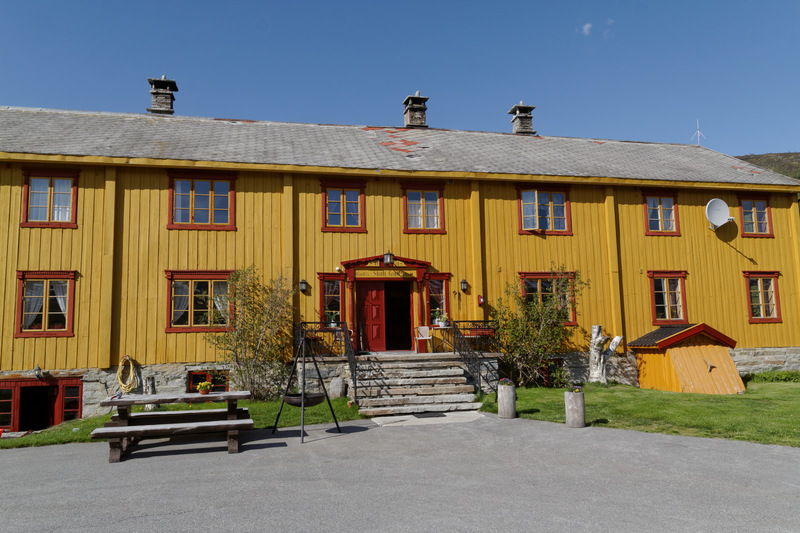
The main building |
We'd parked the car and were taking pictures when the owners came out of a small outhouse, greeting us. They explained that in May they pretty much lived in the outhouse, because of the lambing. After the first hellos and so on there's a little pause. Then Wenche, our contact, says "we do have beer for you, but ... you know ... most people don't actually like the beer. We give them pils and maltøl, but they usually leave the maltøl behind. Some people say it smells like a barn." Martin and I look at each other again, both thinking: this is either very good or very bad, but at least it sounds reassuringly authentic.
They take us into a big dining room in the main building, which is a big, wooden house that must be about a century old. The decorations are classic Norwegian farmhouse, which in this case is entirely appropriate, as this is a farm. It's from the 17th century, they tell us, and at 60,000 acres one of the biggest private farms in Norway. In addition to being a farm, they also are a kind of inn, offering guests food and lodging. It's a fantastic place for it. I'd love to stay here even if it weren't for the beer.
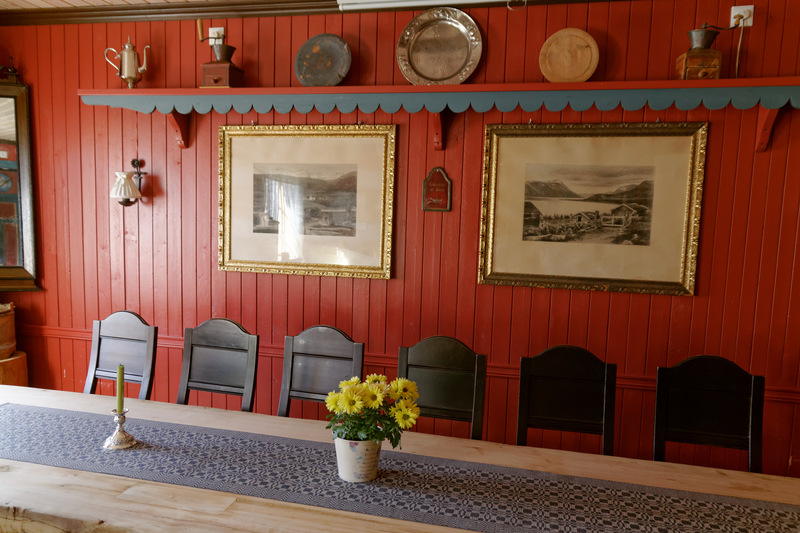
The dining room |
Then they disappear, to finish up preparing the food and beer, leaving us to ponder what on earth it is we're about to receive. Nobody likes it, and it tastes of barn? Surely this has got to be authentic. But what is it? Is there kveik? Is it like what we've had before? Or like the beer from Stjørdal, not too far away? I can feel my heart going bump-bump-bump as anticipation builds.
Then they emerge with a steaming kettle of traditional sour cream porridge, some flatbread and cured meats, and the beer. I immediately take leave of my surroundings and dive into the beer. Small, coarse white head, over hazy reddish brown body. Clearly low carbonation. The aroma is fruity and dominated by delicately smoky juniper with spicy notes. Wow. I break into a huge smile, then take a sip. I'm greeted by a smoky barnyard and straw flavour, somewhat dry and astringent, with fruity spicy notes. The body is not exactly thin, but you can tell there's not a lot of sugar. Toward the end it goes quite bitter, with a smoky, wooden lingonberry flavour. Kind of like stjørdalsøl, but more rustic. It's a bit rough, it really does smell like a barn, and I really enjoy it.
Returning to the world around me, I look up, to see happy relief on the faces of my hosts, and realize they've been watching us to see whether we like it. From the way we're laughing and ecstatically discussing the details of the flavour there can be no doubt we're really enjoying it. Personally, I'm ecstatic. What a find! Not only is it unlike anything I've ever had before, but it's good, and highly drinkable. I can see why people used to nothing but pilsener might be shocked by something so rustic and utterly different as this, though.
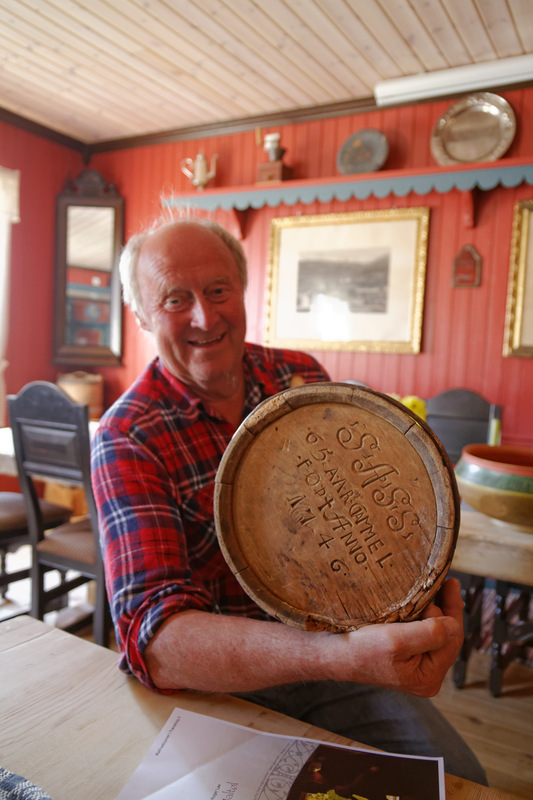
Harald, the brewer |
The brewer is Harald Storli, the old farmer, whose son is by now taking over much of the actual farming. The son doesn't brew, however, but his wife, Wenche, does. She's married into the family, and seems to be the family spokeswoman, and also the next generation of brewer. I'm really happy to hear Harald has taught her, as that means the beer will live on for another few decades at least.
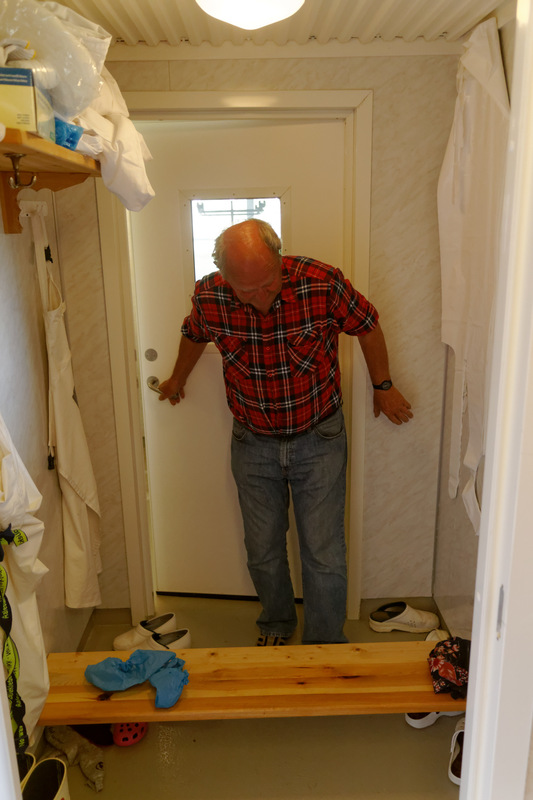
Entering the brewery |
After we've eaten, Harald takes us to see the brewery. By now I'm dying to find out what it is we've actually drunk. We go into the cellar, and then find we have to pass through a changing room, putting on plastic covers on our shoes etc to ensure cleanliness. What on earth is this? It turns out they produce smoked lamb and sausage on the farm, and to be approved by the Food Safety Authority they have to have these sanitization measures in place. And, by chance, the brewery happens to also be down in the same rooms.
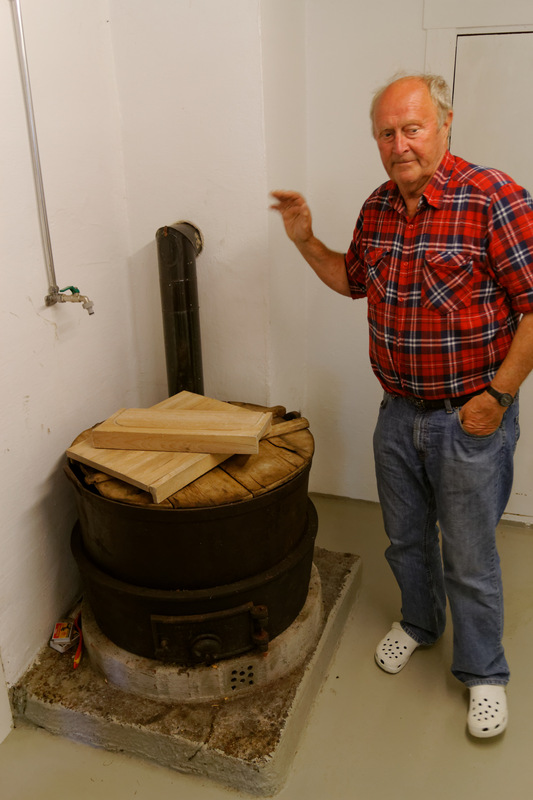
The kettle |
In a corner is the by now expected sight: circular wood stove, heating a big iron kettle. Then, in the room beyond are a wooden barrel, and some small wooden casks, then two little vats. I'm still waiting for Harald to show me the brewery when I realize that this is in fact it. This is the whole thing. There is no more equipment. That's the first shock.
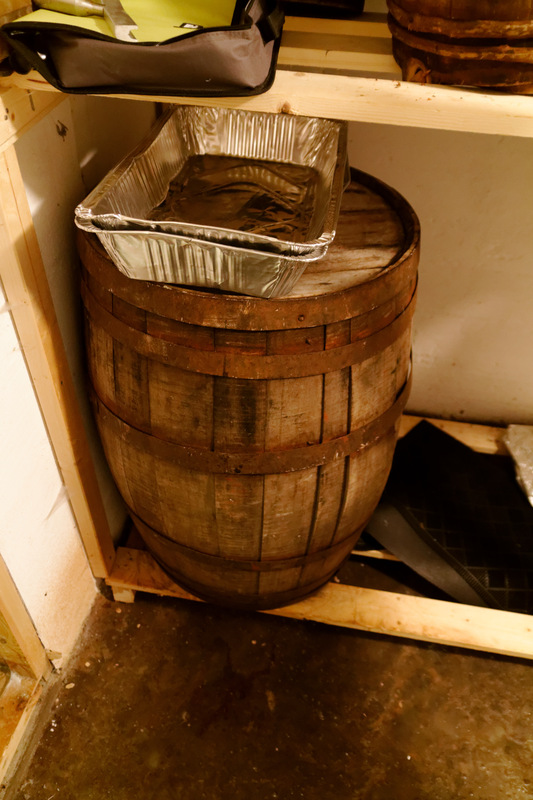
The fermentation vessel |
Then Harald explains how he brews. It turns out the kettle is only for preparing juniper infusion for the mashing, and for boiling the first and the last buckets of wort with the hops. The rest of the wort is never boiled at all! So what we've tasted is in fact a raw ale. What about the hops? That turns out to be pharmacy hops, just a little, to protect the beer against infection. What about the yeast? Oh, that's baking yeast. No kveik.
We try asking Harald if he still has kveik or if there ever was kveik on the farm. He tells us he doesn't have any, and can't remember any ever being used. Then later on, in the middle of explaining something else, he breaks off, then tells us that actually, they did have kveik on the farm. When he was a child they'd dry the yeast on wooden boards, and he had the task of knocking the chips off with a hammer, to prepare it for use in the next brew. So, yes, they did have kveik, but it must be 60-70 years ago now.
What about the malts, we ask? It turns out he makes those himself, then drives down into Oppdal to have them ground on a malt mill he borrows. He does this because his own mill is broken, he says. I look at him, thinking, "driving all the way there and back to borrow a mill sounds like a lot of unnecessary hassle." Little do I know. We go up, out of the cellar, then round to the back of the house. There, in the middle of a field, is the malt house. Off to the right, by the brook, is the malt mill. The mill turns out to be one of those centuries-old mill houses directly powered by moving water.

Walking to the malt house |
Harald opens the door to the malt house, then explains the process. He buys grain from Røv Mølle in Surnadal, then puts it in a cloth sack in the brook for three days. It sprouts, both green shoots up the side of the kernel, and tendrils, causing the grain to stick together in one hardened mass. To tear it apart, he rubs it between his hands, he says. I just stare at him. This is a brewer who actually touches every individual grain of malt with his hands. And I thought driving to Oppdal to borrow a malt mill was a lot of work. Little did I know.
He then spreads the green malts out over big slate shelves inside the malt house. These sit above a brick fireplace, which he fires for 2-3 days, taking care to let it burn almost down before he stokes the fire with new wood again. The process requires careful supervision and attention. At the end of it he has 75 kilos of malt, having started with 100 kilos of barley grain.

Harald outside the malt house |
He explains that before grinding the malts he removes the green shots and the tendrils. "In Stjørdal they don't do that, but then it's been burned, and leaves a horrible, burnt smoky flavour in the malts," he tells us. Finally, he used to grind the malts in the mill driven by the brook. This has to be done in summer, because the rest of the year the brook doesn't have enough water to power the mill. It takes about 2-3 hours for the 75 kilos of malts. Driving to Oppdal and back to have it ground is probably faster.
We go back round the house, to say goodbye to our hosts. Standing on the steps to the house, Wenche explains that they don't actually charge guests for the beer. They have approval from the Food Safety Authority, but the excise regime is just too much. And anyway, nobody likes the beer. After brewing Harald drives round to the locals, giving away beer to each. She doesn't do that, she says. She only gives it to a few, select people, those she knows really enjoy the beer.

On the stairs of the house |
By now I'm almost in shock. They make this fantastic beer, requiring an almost absurd amount of labour, and then, not only do they give it to guests for free, they also give it to locals for nothing. At the end of all this, none of the guests like it, despite it being an utterly unique and authentic beer, one of the few pieces left of the original Norwegian beer culture. It's so sad I don't know what to say to them, except to repeat that we really enjoyed the beer.
At Cantillon, the owners get upset if you call the brewery a museum. And rightly so, because the brewery is very much alive. It's a real, working brewery. Rather like this brewery. They brew and malt almost exactly as it was done three, four centuries ago (only the yeast and the hops are different). Usually you have to go to a museum to get a glimpse of something like this, but in this case it's not a showpiece. It's real. What they've done is to keep a little piece of the past alive. It's not in a museum, it's living and breathing, even if it's centuries old.
It's at this point that Francis and Martin, mindful of how long we still have to drive to get to our next stop, gently tear me away and shove me into the car. I had so many questions left to ask, but there just wasn't time. This was just a chance stop for dinner, a small detour we added to the trip in case it might be interesting. As we drive off, I'm torn between happiness at such a magnificent find, and frustration that we couldn't stay longer.
Please note: You can't just drive here, expecting to be served food and beer. They have to know you're coming. Also, the beer doesn't keep, and making it takes a crazy amount of work. So you have to book ahead, then ask if they will please, please, please spend a few days making beer for you. If you're lucky, they will, or they're doing it anyway, but remember that to provide a sample of this beer requires more than simply turning on the tap.
(Martin's blog post about Storli Gard.)
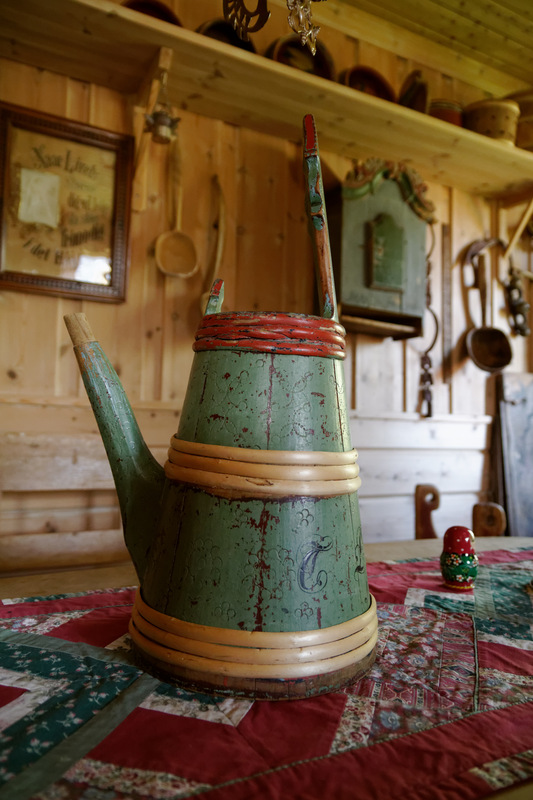
Old beer can |
Recipe
I'm not sure giving a recipe for this beer is very useful, even if you can get hold of Norwegian baking yeast, as I suspect a major source of the flavour is actually the microflora of those wooden vats. Plus, you need to make malts at least roughly the way Harald and Wenche do it. So this is a very difficult beer to reproduce. Still, for anyone wanting to know the detail of how it's made, here comes the data. Note that my source for this is not just what Harald told me, but also Roger Løe's excellent booklet on Maltøl, available from Mære Landbruksskole. (It's in Norwegian. Write them an email and they'll sell you a copy.)
Boil juniper to create juniper infusion. Put 36 kilos of ground malts into the mash tun, then pour boiling juniper infusion on it. Once you've put in about 60 liters the mashing fork will no longer stand by itself, and you have the right amount. (The temperature at this point has been measured to 75C, but Harald doesn't actually use a thermometer.) Cover the mashtun with a lid and a blanket, and leave it alone for 3.5 to 4 hours.
Now start the runoff. (Temperature at this point has been measured to 65C.) Transfer the mash to "stetta," which is a wooden vat with a false bottom, under which about 30 cm of juniper branches have been put. There's also a rod with slits in it, just where the wort runs out of the vessel. Use buckets and a ladle to transfer the runnings back into the now cleaned mashtun (soon to be fermentation vessel). For every bucket of wort you take out, pour in a new bucket of boiling juniper infusion. Harald usually takes out about 12 buckets of wort, or 140 liters.
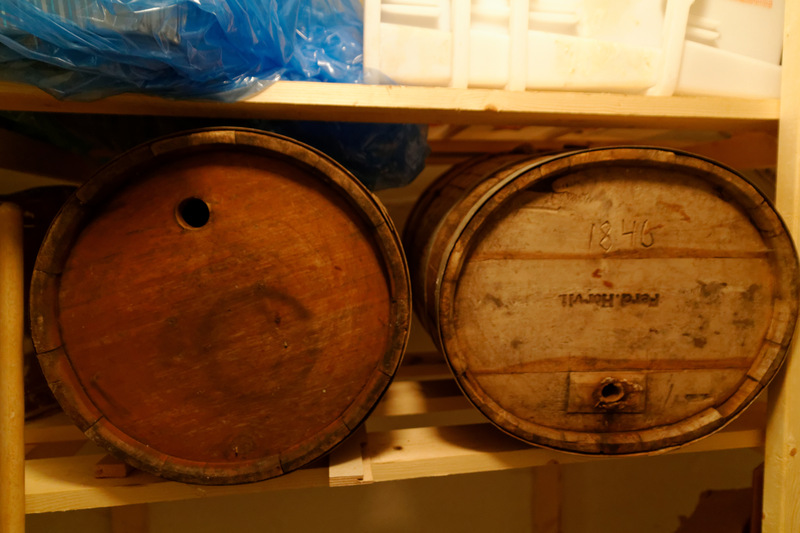
Wooden casks |
The first and the last bucket of wort are put back into the kettle, together with about 460 grams of hops. These are boiled until about half of the volume has evaporated. Strain through a sieve, and mix with the rest of the wort.
Remember not to boil the rest of the wort!
Harald usually cools the wort by putting it into smaller buckets and containers and putting these out in the snow or the brook. That takes 2-3 hours. (The sugar content was measured once, and found to be about 10%, that is an OG of about 1040.)
Once the wort has been cooled, add Norwegian baking yeast by squeezing it onto juniper branches, then put the branches in the fermentation tun. The branches float on top of the wort, and once the yeast has come off the branches (takes 16-24 hours), primary fermentation is over. Transfer the beer carefully to wooden casks. Add sugar (2 tablespoons per 50 liters) to start secondary fermentation. After about 2 days of secondary fermentation, put the bung into the cask, and seal with wheat flour.
Store in the cellar, and enjoy within 3 weeks.

Going to the malt house |
Similar posts
Alstadberger
Driving hurriedly on from Storli Gard, we arrived at the island of Tautra outside Trondheim late at night
Read | 2014-09-03 19:59
Hegra maltøl at Granås Gård
Our final stop on the trip was actually the first to be planned
Read | 2014-09-09 17:20
Brewing koduõlu on Hiiumaa
On Hiiumaa we drove off the ferry, then a couple hundred meters up the main road, turned off, and within a few minutes we were outside the house
Read | 2018-03-11 15:06
Comments
hophead - 2014-08-19 11:24:04
This was fascinating, thank you very much for sharing!
sam - 2014-08-19 19:05:06
this is really cool. i wish i could go there.
George - 2014-08-20 15:42:45
Another good book that covers this kind of beer in detail: Brewing and beer traditions in Norway. The social anthropological background of the brewing industry. Odd Nordland, 1969.
He remarks how he's glad he was finding the old men and women who knew about traditional brewing in Norway, but that it was fading fast. That was 45 years ago.
George - 2014-08-20 15:51:49
Ah! Never mind. I see you've read Nordland's book. http://www.garshol.priv.no/blog/287.html
Lars Marius - 2014-08-20 15:54:09
@hophead and sam: Thank you. :)
@George: As you discovered we read that book to prepare for the trip. Unfortunately, it's nearly impossible to get hold of, but we're trying to see if something can be done about that.
I've now managed to get hold of some of the material he based the book on, and it's clear that the tradition died out in most of Norway in the period 1850-1920, and then much of what remained died 1920-1950. So what's left is just a tiny fraction of what we had not very long ago. I intend to do a blog post on that later.
Levi - 2014-08-26 16:47:30
Awesome as always! Thanks for sharing!
Quentin MANGEL - 2020-12-06 18:07:50
I just have to say thanks ! Can't stop reading your amazing blog !!
I brew small batch of raw ale in wooden vats in France since... two days ago ! And all your work is really inspiring for my next batches.
Those beer are interresting in taste, the process is much fun, but also important : it's better for the environment because of the low-tech process !
Thanks again